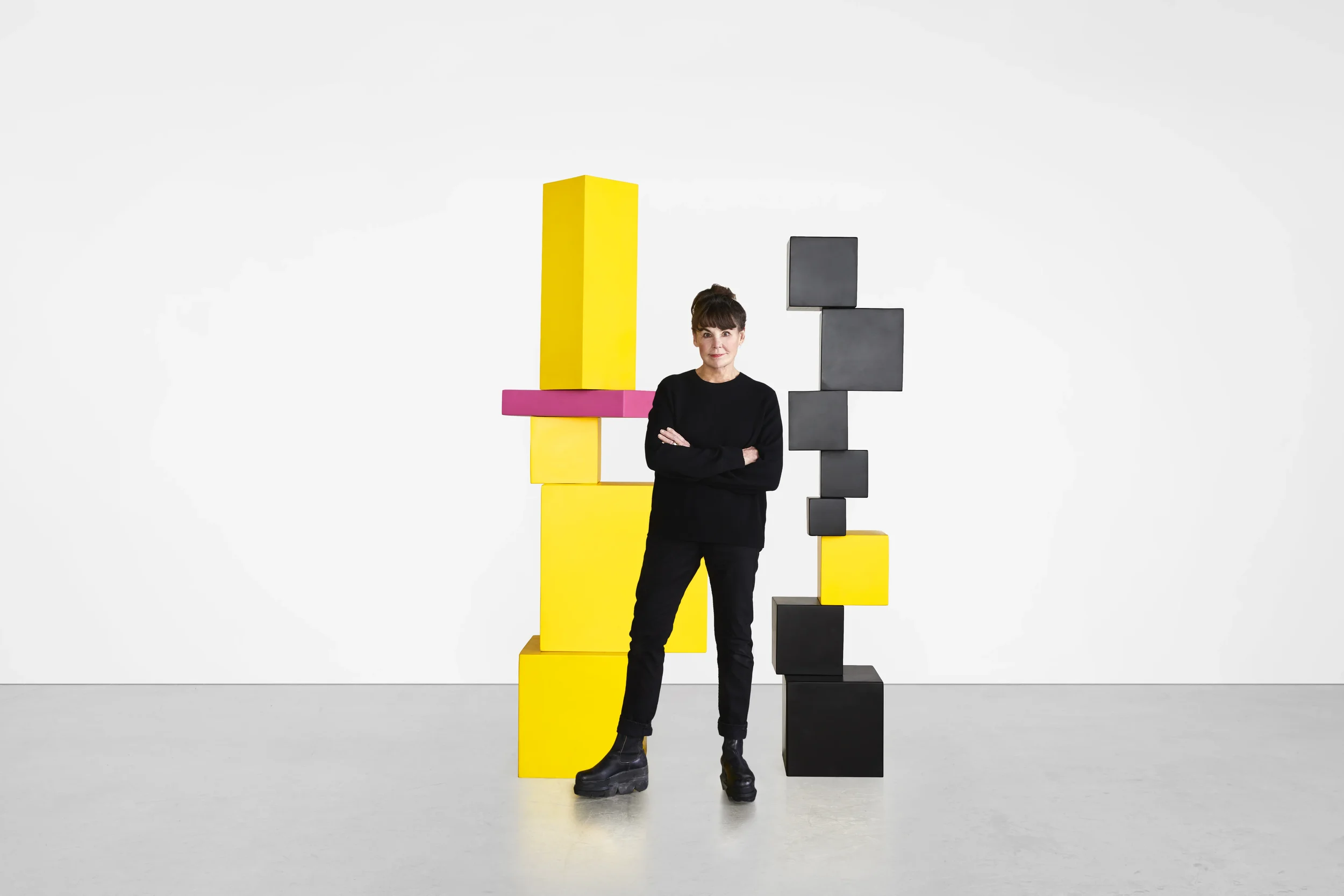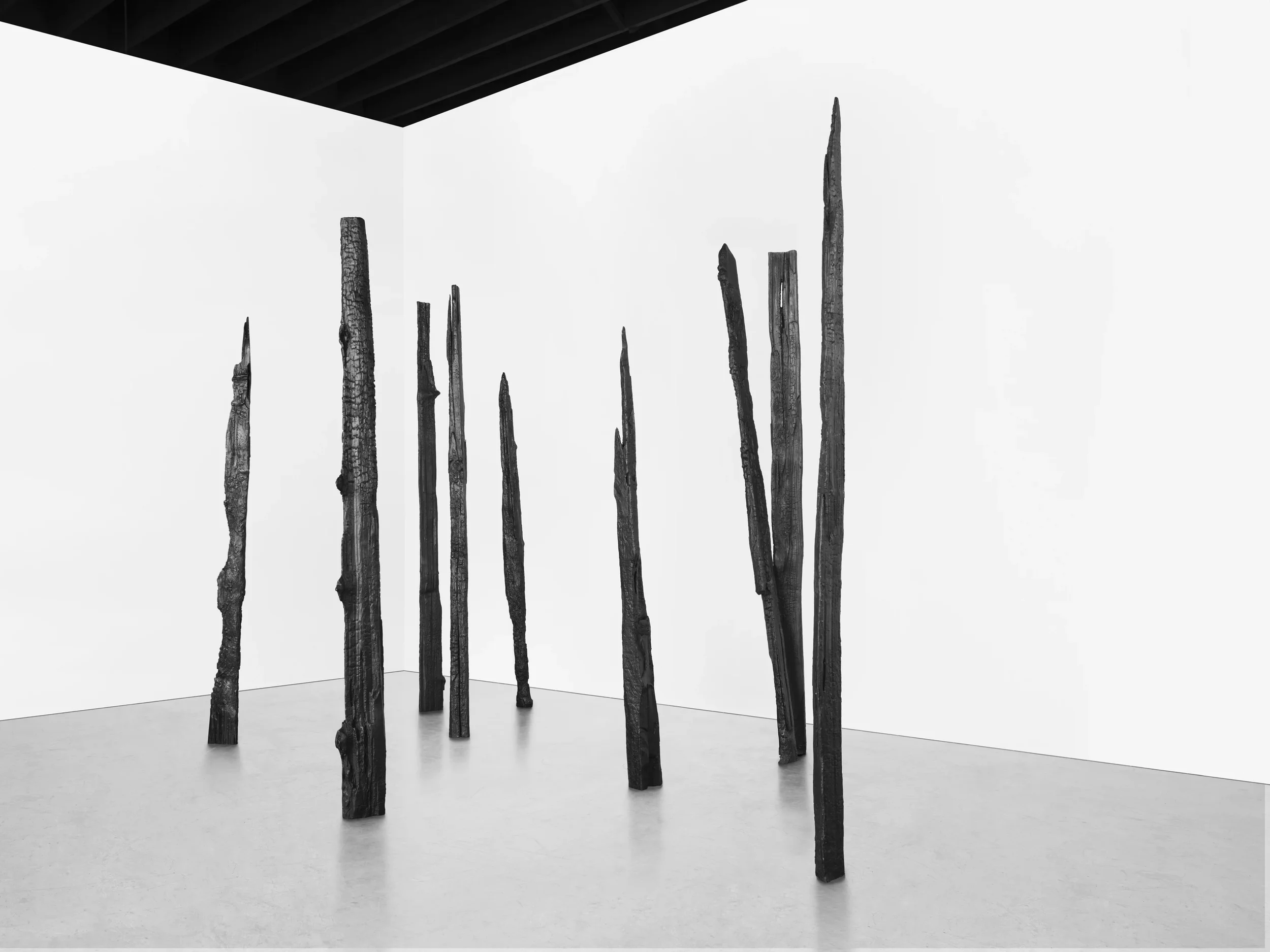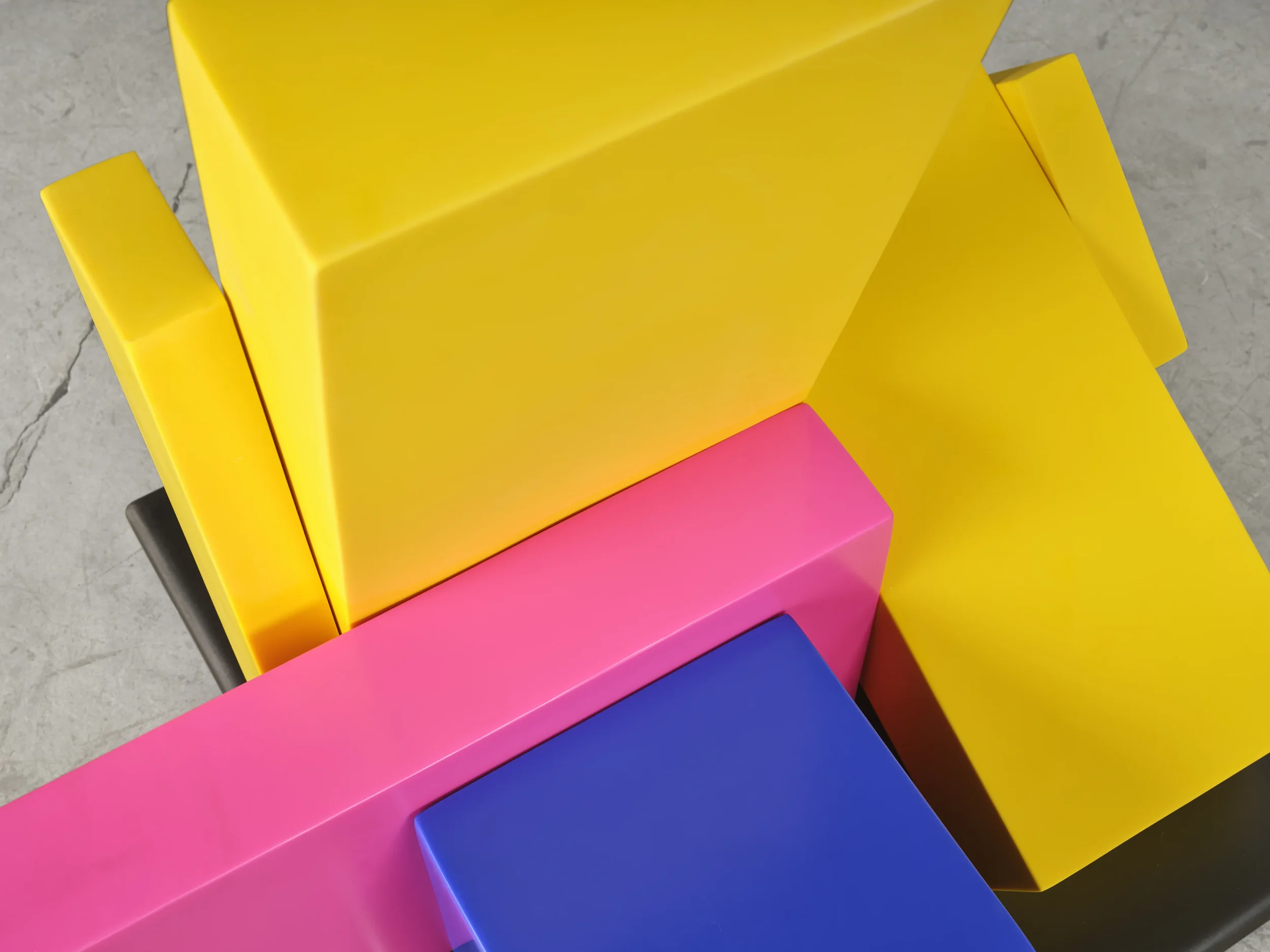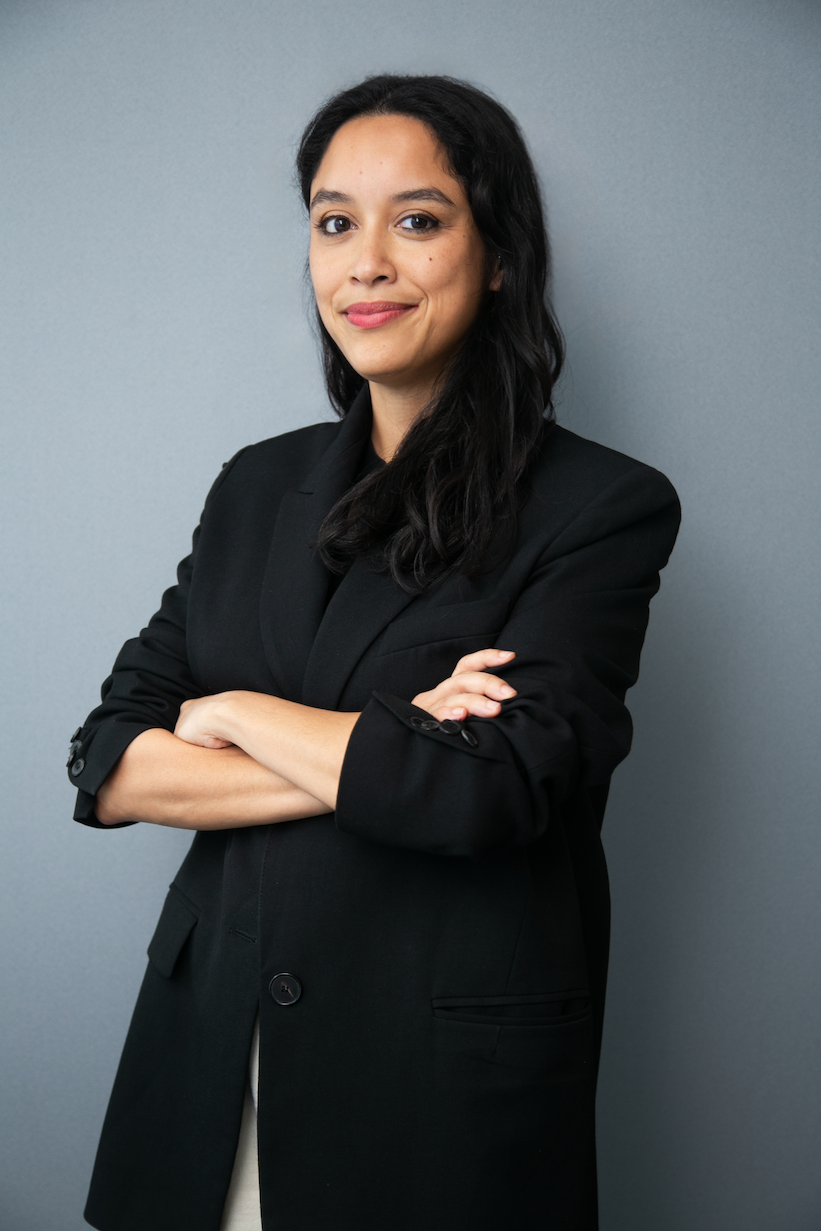In Conversation With: Martha Sturdy
Renowned for her monumental forms and fearless engagement with material, Canadian sculptor Martha Sturdy has long celebrated the dialogue between nature, abstraction, and the handmade. Her practice, spanning resin, brass, steel, and reclaimed wood—embodies both strength and serenity, reflecting the landscapes of British Columbia that so profoundly inspire her. Sturdy’s work balances bold physicality with an instinctive sense of refinement, transforming industrial materials into expressions of rhythm, emotion, and energy.
In conversation with The Fluxx, Martha shares insight into her process, the intuitive way she approaches scale and form, and how nature continues to shape her creative journey.
Balanced Unbalanced series in resin and steel. Photography: Raeff Miles
Your sculptures often seem alive with movement, whether it's the flow of your Brass Landscapes or the vibrancy and balance of others. What draws you to a particular form or gesture when you begin a piece?
Usually, I think about it in bed. And when I come to the studio and start playing with material or shapes or colour. I will go and make my own colours in resin. I’ll actually make a colour that I am thinking about, and then I paint or pour resin in a shape, and then I add to it. Or, if I don't like it, I'll saw it up on a band saw. It's just instinctive. I know what has to be a certain way. I just know. And that's because I've had a practice forever, so I really hone down what shapes I like and what scale. I love big, and bigger is better.
Can you walk us through a moment when a material surprised you, when it resisted or changed the course of a piece entirely?
I can come to the studio and think I’m going to be in the workshop area, and I don't feel anything, so I don't even bother. I find that in the morning, when I'm by myself, I'm better at making things. I like freedom and not being watched. I'm happy to come in on a Sunday and not have anybody here, and then it just happens, it is what's in my brain. My theory on my work is two things: I'm pointing now to my head and my heart combined. That's how I work.
Brass Landscapes series. Photography by Raeff Miles.
Is there something that happened with different materials that informs how your work turns out? Like, how does a brass decide to be manipulated or steel?
Usually, what I do with brass is bend it into the shapes I'm thinking of, and then I come back in an hour or two and look at it again. And then I say, nope, it doesn't work, or yes, it does work, or it needs to go in this direction or that direction, and I know, mainly because I've played with material for so long.
Your work has a very tactile quality. How important is the physicality of making?
Oh, very important! It's what I'm about. I love material and I love working with it. So, it's the fun part of my life.
How would you describe your relationship with the different materials that you use?
Well, it depends on what you're working on. If it's colour, I've been doing a lot of green. All shades of green, and that's because I've been looking at trees. There's black, green, yellow, and blue green; there are so many colours of green. And nature, especially in British Columbia, is very lush and green, so we often ignore it, block it out, and don't even talk about trees. But lately, I've been thinking about how each tree has its own personality, shape, strength, power, and drama. Trees are such a luxury, and we have that luxury in British Columbia, so we're very fortunate.
Unbalanced in resin and steel. Photography by Raeff Miles
How do you know when a sculpture is finished?
Oh, it is. It's just finished. Don't touch it because if things look overworked, they're ruined. You know.
Is there a historical artist or a sculptural tradition that you find yourself continuously drawn back to?
I am what I am, and that’s what I focus on. Mexico, in general, has had a powerful influence on me because, in Canada, we are very drawn to concrete, dark green, and silver aluminium in architecture. The first time I saw the work of architect Ricardo Legorreta, it was so flamboyant and unconventional. In Mexico, the colours are simply fabulous, and it’s unfortunate that, as Canadians, we are so reserved that we don’t appreciate—or even think in—that way. This is how we should think, because it’s positive and uplifting, whereas muted, toned-down elements can feel dull. There’s no passion.
Japan has also influenced me. Japanese art, depending on its origin, often features refined shapes. They edit, edit, edit—I used to say that all the time. What you’re supposed to do with art is edit. The more you put in, the messier it becomes. The Japanese have perfected this approach, refining their work down to its purest graphic lines.
Balanced Unbalanced series in powder coated aluminum. Photography by Raeff Miles
Do you ever revisit a past work or a past series with new eyes?
I looked at a photograph of my sculptures in the field today. Recently, when I was at my farm in Pemberton, looking at the tall grass surrounding the sculptures, they looked quite fresh, even though it was the same art. The grass was white and yellow, taller, and flowed more naturally with the metal. And the sky was a brilliant blue. The environment around the sculptures can change them so much—the way they interact with what grows around them really matters.
What role does sculpture play in the art world?
People like things that hang on the wall because they’re practical. Sculpture, on the other hand, is always inconvenient. It’s three-dimensional, takes up space, and is, in a sense, totally unnecessary. Sculpture is like the human body—it’s another form. It’s right there, and you have to engage with it.
If you walk down a hallway with art on the walls, maybe it’s great, maybe it isn’t. But when you enter a hallway where there’s a sculpture large enough to walk around, suddenly you have no choice but to look at it and interact with it. Sculpture should be part of everyone’s world because it feeds you.
A sculpture is inconvenient and impractical, but to me, it’s often related to the human form. Whether it’s see-through, solid, beautiful, or ugly, you can’t help but have some kind of response to it.
All Fall Down – Bronze2022. Photography Raeff Miles
Are there any art or design-focused spaces that you enjoy visiting in your life? Where do you go?
The forest—that was easy! In an old forest, it’s mostly just dirt. Nothing grows because the trees are so large that they block the light; in that sense, an older forest can feel like cleared land. A newer forest, or the forest’s edge, is full of smaller deciduous trees, bushes, and grasses. But when you get into the deep forest, it’s just big trees.
When you look up, it’s mind-boggling. It’s so beautiful. You see a tree that might be one foot across—or eight feet — and when you stand at the base and look up, you feel its power. You see its strength and beauty, and then the canopy takes your breath away. It’s the trees deep inside the forest that captivate me, and an old forest is entirely different from a young one.
We can tell that nature is important to you. What connection does nature have to your work?
There’s so much happening in a forest. Sometimes the bark has fallen off, or something has struck the tree, or the tree leans in the most unexpected way. It seems like it should fall, but it doesn’t. How does that happen? I think there’s so much about nature we don’t give enough credit for. In a way, trees are like a different language or a different society. They give you information that people don’t, yet they don’t speak. Our judgment of trees isn’t fair, because we don’t truly appreciate what they have to teach us—even though we use them in so many ways.
More people would benefit in life if, instead of walking down streets looking at impressive buildings, they spent time in the forest and learned from nature.
Brass Landscapes series. Photography by Raeff Miles.
You often say that ‘everything matters.’ Could you talk about how personal style fits into that—how it reflects who you are and shapes your life?
Well, I grew up, I’d say, in the upper middle class. My father was a clothing manufacturer, and I always wanted things, but there wasn’t a budget for me to have what I wanted in fashion. I started reading Vogue magazine when I was probably ten. I would go to the drugstore, which sold magazines, and sit there looking through Vogue without buying it because I didn’t have the money. What I loved about Vogue was everything—the women were beautiful, the clothing had exquisite lines, and much of it was very sculptural. That was an early influence on me. I also always drew. In grade five, I was constantly sketching. There was a book we were reading in class about the 18th century, with women in long dresses—the romance of shape, in a world so different from my own, really appealed to me.
Going to art school was the best thing that ever happened to me. Did they teach you art? Absolutely not. Nobody can teach art. You either know it, or you don’t. You can learn materials and techniques, but you can’t learn how to be an artist. You can learn how to work with materials, and, over time, with guidance, how to look at things—but most artists can see what is good or not because their priority is looking—really looking—at everything all the time.
You notice details in ways others might miss: the way a dog who likes you lies by your feet, curves toward you, or sits beside you on a bench. You learn about love by observing the interactions of two people, two animals, or even an animal and a person. There are things you only understand by learning how to read them—by being a careful observer with an open mind. Everything can be ugly or beautiful, depending on how you interpret it.
Unbalanced in resin and steel. Photography by Raeff Miles
Speaking with Martha Sturdy reveals an artist deeply attuned to both the natural and material worlds; a creator whose intuition and honesty define each piece she brings into being. Her reflections remind us that sculpture, in its most authentic form, invites interaction, emotion, and contemplation.
We extend our sincere thanks to Martha for sharing her time and thoughts with The Fluxx, and we very much look forward to seeing what creations develop in the future.













